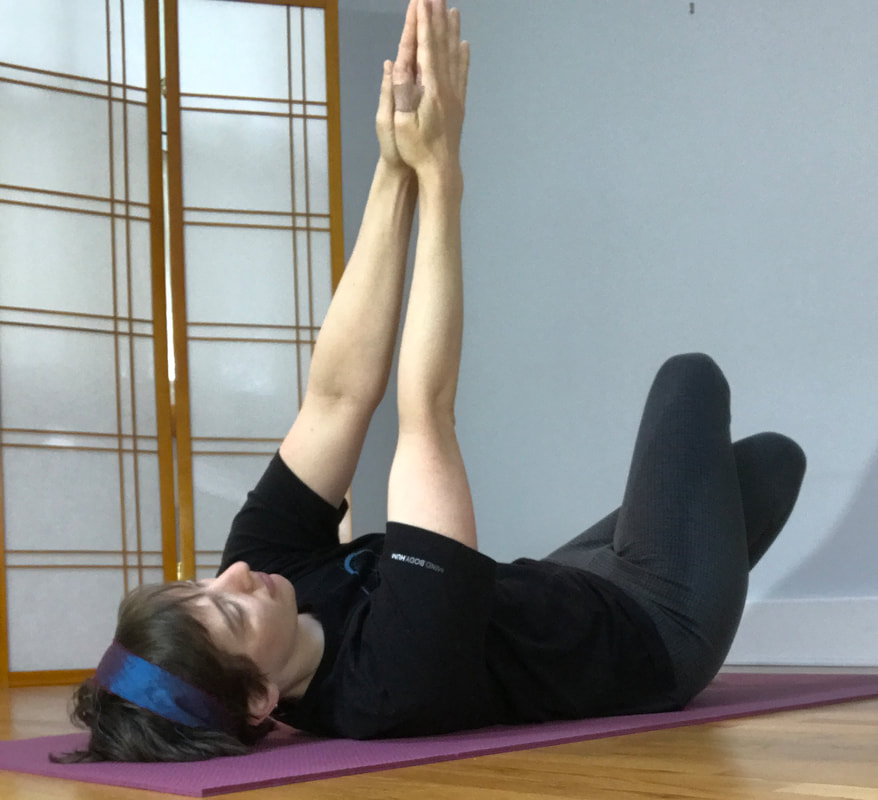|
What are the benefits? How long should I take Awareness Through Movement® classes? These are the questions my student asked yesterday. (New class starting June 4) Here is part of my answer:
Feldenkrais is focused on functioning and moving more effectively, with less effort (less effort often also means less stiffness and less pain as well). This happens though meditative movement with awareness, through sensing how we move. Feldenkrais is empowering, because it relies on growing our own experiences of ourselves as the basis for learning and becoming more effective in movement and in life. I find in ATM class, I change the whole tone of my system, which used to be turned up to high all the time. I find it more powerful than stretching, because the change is deep within the brain, not within the muscles. I've stood up after lessons and been able to bend in ways that people spend years stretching to find. The way we move the bones helps the muscles find better organization and coordination. I find it more powerful than chiropractic, because except for rare events, I can reorganize myself so I don't get into trouble. When I do get into trouble, of course I go to the chiropractor. Otherwise, I do an Awareness Through Movement® lesson . Functionally, what that a lesson might look like is this: 1. Example: I have back pain--upper, and lower. 2. I go to Awareness Through Movement class and we do some movements that have something to do with turning the head and eyes with the neck--seemingly disconnected from my back. 3. As we explore the movement, some of my habits that have tagged onto the way I turn, fall away. That means muscular tension, gritting teeth, holding my shoulders still, not breathing, etc. Some of what we do seems a bit ridiculous, and sometimes we laugh. 4. I stand up, and can turn my head much more easily, and strangely enough, my balance is also improved, and my back doesn't hurt as much, because a lot of my back pain is actually associated with how I hold my head. 5. I go home, noticing that I need to adjust all the mirrors in my car (and that after an hour class). 6. The next day, after a deep sleep, I find that some of it has stayed, and some has gone. I've integrated some of the work, and some of it has gone into the background. It will be easier to find later, when I've had more experience with it. And lastly, when I get really good at it, I can tell what I am doing, and I can choose to use my neck and head in a way that doesn't cause pain. And, I do this without a lot of conscious work, but because my body has found out a way, through play and experimentation, to organize more successfully. What is happening? We are working on retraining the brain--deeply working with the connections our brain makes with our bodies, and that affects function. That affects rest. That affects how we stand, balance, approach life, and ourselves. How long do people do this for? I am insatiably curious--I will do this forever. When I taught last Tuesday, one of the students forgot to take her cane with her. She used it to get to class. Sometimes it is like that. It really depends how much we are entrenched in a pattern that isn't serving us. But, what I also love is that what you learn is yours. You take it with you, and it becomes part of what you do, and how you use yourself, and that means that every little bit is a plus.
0 Comments
Leave a Reply. |
AuthorHeather Emanuel, is a Guild Certified Feldenkrais Method® Practitioner, Assistant Trainer, LMT, and Awareness Through Movement® facilitator. She also teaches Restorative Yoga. Free and subscription classes also are on PATREON.
As an artist, she has won accolades for her playful portraits. These days, she's pouring her creativity into her Feldenkrais work. Just as her art explores expression, playfulness, identity, and the possible, so do her movement sessions. Her art CV is here. Recorded classes on Patreon for free or a small subscription. Archives
January 2024
Categories
All
|
Heather Emanuel, GCFPSchedule Appointment
|
|


 RSS Feed
RSS Feed